-
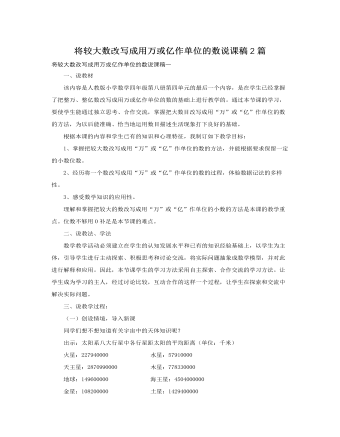
人教版新课标小学数学四年级下册将较大数改写成用万或亿作单位的数说课稿2篇
一、说教材该内容是人教版小学数学四年级第八册第四单元的最后一个内容,是在学生已经掌握了把整万、整亿数改写成用万或亿作单位的数的基础上进行教学的。通过本节课的学习,要使学生能通过独立思考、合作交流,掌握把大数目改写成用“万”或“亿”作单位的数的方法,为以后能准确、恰当地运用数目描述生活现象打下良好的基础。根据本课的内容和学生已有的知识和心理特征,我制订如下教学目标:1、掌握把较大数改写成用“万”或“亿”作单位的数的方法,并能根据要求保留一定的小数位数。2、经历将一个数改写成用“万”或“亿”作单位的数的过程,体验数据记法的多样性。3、感受数学知识的应用性。理解和掌握把较大的数改写成用“万”或“亿”作单位的小数的方法是本课的教学重点。位数不够用0补足是本节课的难点。
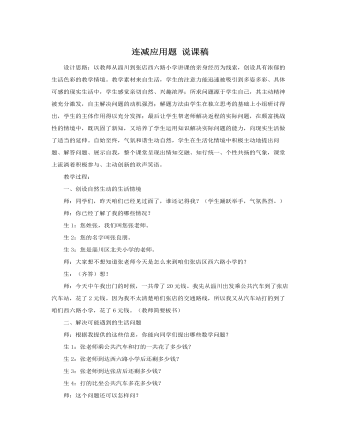
人教版新课标小学数学二年级下册连减应用题说课稿
设计思路:以教师从淄川到张店西六路小学讲课的亲身经历为线索,创设具有浓郁的生活色彩的教学情境。教学素材来自生活,学生的注意力能迅速被吸引到多姿多彩、具体可感的现实生活中,学生感觉亲切自然、兴趣浓厚;所求问题源于学生自己,其主动精神被充分激发,自主解决问题的动机强烈;解题方法由学生在独立思考的基础上小组研讨得出,学生的主体作用得以充分发挥;最后让学生帮老师解决返程的实际问题,在颇富挑战性的情境中,既巩固了新知,又培养了学生运用知识解决实际问题的能力,向现实生活做了适当的延伸。自始至终,气氛和谐生动自然,学生在生活化情境中积极主动地提出问题、解答问题、展示自我,整个课堂呈现出情知交融、知行统一、个性共扬的气象,课堂上流淌着积极参与、主动创新的欢声笑语。教学过程:一、创设自然生动的生活情境师:同学们,昨天咱们已经见过面了,谁还记得我?(学生踊跃举手,气氛热烈。)师:你已经了解了我的哪些情况?
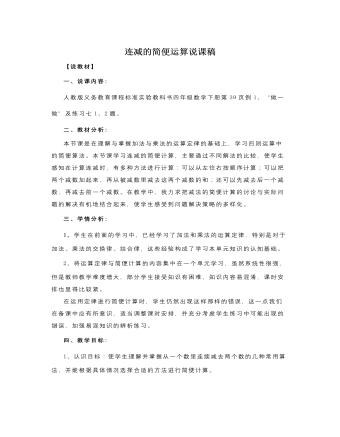
人教版新课标小学数学四年级下册连减的简便运算说课稿
在运用定律进行简便计算时,学生仍然出现这样那样的错误,这一点我们在备课中应有所意识,适当调整课时安排,并充分考虑学生练习中可能出现的错误,加强易混知识的辨析练习。 四、教学目标:1、认识目标:使学生理解并掌握从一个数里连续减去两个数的几种常用算法,并能根据具体情况选择合适的方法进行简便计算。2、能力目标:培养学生根据实际情况灵活选择算法进行计算的意识与能力,提高学生观察比较能力和思维的灵活性,发展学生思维。 3、情感态度价值观目标:通过学习活动,激发学生的学习兴趣,使学生感受到数学与现实生活的联系,学会用所学知识解决简单的实际问题。 五、教学重点: 理解并掌握从一个数里连续减去两个数的几种常用算法,并运用其进行一些简便计算。
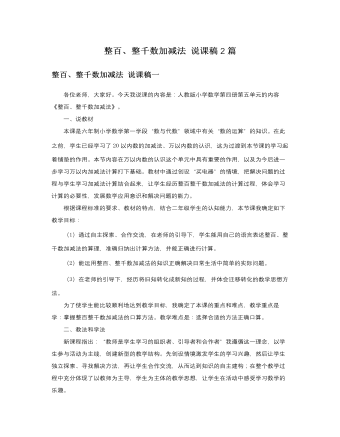
人教版新课标小学数学二年级下册整百、整千数加减法说课稿2篇
2.生活情境导入:昨天,老师去逛了逛家电商场,并记下了几种家电的价格,其中,电视机4000元,冰箱2000元,热水器800元,电饭煲300元,电水壶70元,电风扇90元,出示PPT课件。根据这些信息,你能提出哪些关于加减法的数学问题呢?将自己提出的问题写在练习本上,并列式计算。(二)新课探究,整理归纳1.指导学生提出问题,并板书,(1)电视机比冰箱贵多少元?(2)电视机和热水器总共要多少元?(3)冰箱比热水器贵多少元?2.让学生回顾以前学过的旧知识,列式并解答问题。并说说自己的算法,课堂上交流算法,教师板书,让学生充分体会算法多样化。在讲例题时,不仅在于怎样解,更在于为什么这样解,而及时对解题方法和规律进行概括,有利于学生的思维能力。
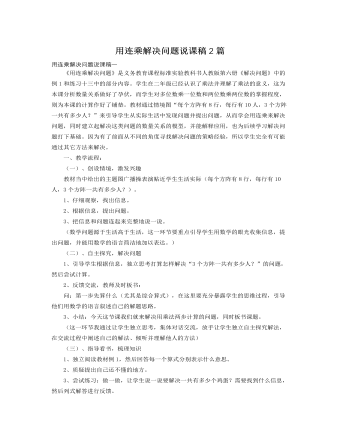
人教版新课标小学数学三年级下册用连乘解决问题说课稿2篇
3、小结比较观察三种方法,提出问题:为什么同一个问题有三种不同的解决方法?学生交流,教师小结:先解决的问题不同,选择的信息不同,图形拼摆的不同,解决的方法就不同,体现数形结合的思想。相同点是:无论思路如何,都是用连乘的方法解决问题。板书课题:解决问题——两步连乘应用题生活中还有很多这样的清况,想不想再尝试一下。(三)联系生活,优化方法,拓展深化,学校有特异为这些参加比赛的同学们购买了矿泉水,出示画面:共有20箱矿泉水,每箱24瓶,每瓶2元,请问学校共要支付多少钱?学生独立完成观察和思考的角度不同,先后选择的信息不同,所以同一道题有不同的解决方法。看来大家多用连乘的方法解决问题有了进一步的理解。生活中类似这样的问题很多,再来看一看:学校定好了水,付了钱,总得运回来吧.出示搬运车搬水到卡车上的画面:搬运车一次搬4摞,一摞3箱,一箱24瓶,请问搬运车一次能搬多少瓶?
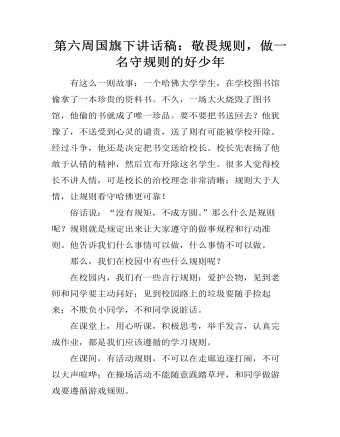
第六周国旗下讲话稿:敬畏规则,做一名守规则的好少年
有这么一则故事:一个哈佛大学学生,在学校图书馆偷拿了一本珍贵的资料书。不久,一场大火烧毁了图书馆,他偷的书就成了唯一珍品。要不要把书送回去?他犹豫了,不送受到心灵的谴责,送了则有可能被学校开除。经过斗争,他还是决定把书交送给校长。校长先表扬了他敢于认错的精神,然后宣布开除这名学生。很多人觉得校长不讲人情,可是校长的治校理念非常清晰:规则大于人情,让规则看守哈佛更可靠!俗话说:“没有规矩,不成方圆。”那么什么是规则呢?规则就是规定出来让大家遵守的做事规程和行动准则。他告诉我们什么事情可以做,什么事情不可以做。那么,我们在校园中有些什么规则呢?在校园内,我们有一些言行规则:爱护公物,见到老师和同学要主动问好;见到校园路上的垃圾要随手捡起来;不欺负小同学,不和同学说脏话。在课堂上,用心听课,积极思考,举手发言,认真完成作业,都是我们应该遵循的学习规则。
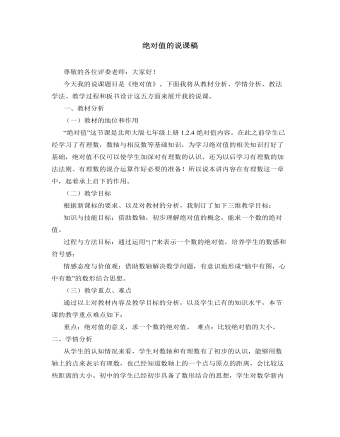
北师大初中数学七年级上册绝对值的说课稿
(三)学以致用,巩固新知为巩固本节的教学重点我再次给出三道问题: 1)绝对值是7的数有几个?各是什么?有没有绝对值是-2的数?2)绝对值是0的数有几个?各是什么? 3)绝对值小于3的整数一共有多少个?先让学生通过小组讨论得出结果,通过以上练习使学生在掌握知识的基础上达到灵活运用,形成一定的能力。(四)总结归纳,知识升华小结时我也将充分发挥学生学习的主动性,发挥教师在教学的启发引导作用,和学生一起合作把本节课所学的内容做一个小结。(五)布置作业,拓展新知布置作业不是目的,目的是使学生能够更好地掌握并运用本节课的内容。所以我会布置这样一个作业:请学生回家在父母的帮助下,找出南方和北方各三个城市的温度,并比较这些温度的大小,并写出每个温度的绝对值进行比较
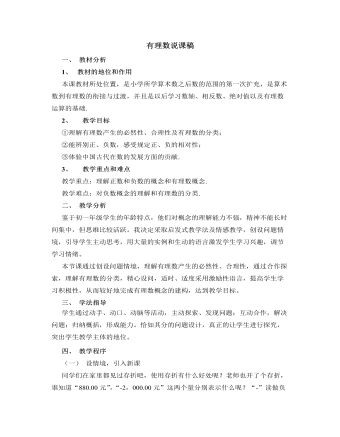
北师大初中数学七年级上册有理数说课稿
1、 教材的地位和作用本课教材所处位置,是小学所学算术数之后数的范围的第一次扩充,是算术数到有理数的衔接与过渡,并且是以后学习数轴、相反数、绝对值以及有理数运算的基础.2、 教学目标①理解有理数产生的必然性、合理性及有理数的分类;②能辨别正、负数,感受规定正、负的相对性;③体验中国古代在数的发展方面的贡献.3、 教学重点和难点教学重点:理解正数和负数的概念和有理数概念.教学难点:对负数概念的理解和有理数的分类.二、 教学分析鉴于初一年级学生的年龄特点,他们对概念的理解能力不强,精神不能长时间集中,但思维比较活跃。我决定采取启发式教学法及情感教学,创设问题情境,引导学生主动思考,用大量的实例和生动的语言激发学生学习兴趣,调节学习情绪。
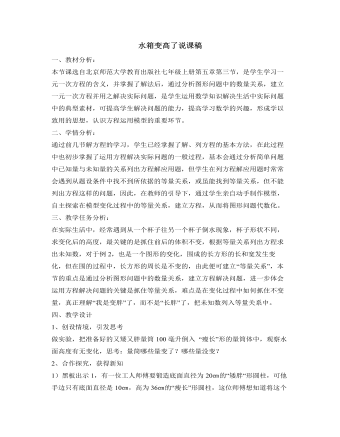
北师大初中数学七年级上册水箱变高了说课稿
一、教材分析:本节课选自北京师范大学教育出版社七年级上册第五章第三节,是学生学习一元一次方程的含义,并掌握了解法后,通过分析图形问题中的数量关系,建立一元一次方程并用之解决实际问题,是学生运用数学知识解决生活中实际问题中的典型素材,可提高学生解决问题的能力,提高学习数学的兴趣,形成学以致用的思想,认识方程运用模型的重要环节。二、学情分析:通过前几节解方程的学习,学生已经掌握了解、列方程的基本方法,在此过程中也初步掌握了运用方程解决实际问题的一般过程,基本会通过分析简单问题中已知量与未知量的关系列出方程解应用题,但学生在列方程解应用题时常常会遇到从题设条件中找不到所依据的等量关系,或虽能找到等量关系,但不能列出方程这样的问题,因此,在教师的引导下,通过学生亲自动手制作模型,自主探索在模型变化过程中的等量关系,建立方程,从而将图形问题代数化。
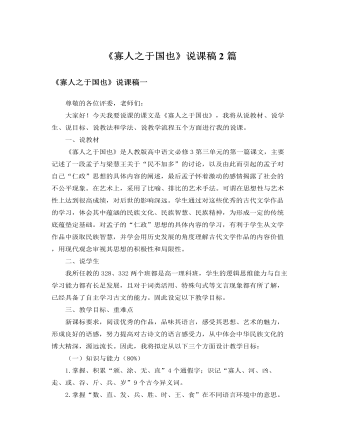
人教版高中语文必修3《寡人之于国也》说课稿2篇
(明确:“寡人之于国也,尽心焉耳矣”,但“寡人之民不加多,何也?”)②他认为自己对国家政务尽心尽力了,他有哪些具体做法?(明确:移民移粟)③第2—4节中孟子是怎样说明梁惠王移民移粟的措施与“邻国之政”并无本质区别的?(明确:孟子不直接回答“民不加多”的问题,而是用梁惠王熟悉的“战”设喻——设圈套,诱使对方在不知不觉中说出“不可,直不百步耳,是亦走也。”)④孟子认为怎样才能做到“王道之始”?要想“王道之成”还需采取哪些措施?(明确:“不违农时,谷不可胜食也。数罟不入氵夸池,鱼鳖不可胜食也。斧斤以时入山林,材木不可胜用也。谷与鱼鳖不可胜食,材木不可胜用五亩之宅,树之以桑,五十者可以衣帛矣。鸡豚狗彘之畜,无失其时,七十者可以食肉矣。百亩之田,勿夺其时,数口之家,可以无饥矣。谨库序之教,申之以孝涕之义,颁白者不负戴于道路矣。)这一小步的目的是想让学生通过这些问题的解答,可以进一步理清思路,掌握文的大概内容。

人教版高中语文必修3《老人与海》说课稿2篇
3、重要语句的理解“可是一个人并不是生来要给打败的,你尽可把它消灭掉,可就是打不败他。”解析:这是老人第一次回合之后的内心独白,也是此小说的核心精神,充分体现了老人桑地亚哥的生命理念。整句话可以分为两部分来理解,前句告诉我们,人生活在自然与社会当中,必不可少要面临一些坎坷、磨难,这些磨难、坎坷完全可以造成躯体的消灭、消亡,这是人生命的脆弱性。后句,面对挫折,只要保持一种乐观的精神,拥有一颗坚强的心灵,那么,人类执着奋斗的精神将永不磨灭。4、象征主义题目是《老人与海》,而表明上,小说是写一位老人及其在海上的经历,但实际上,老人的形象极具概括性,他已经超越了一个人的存在,而成为了人生的一种象征。老人桑地亚哥就是“硬汉子”的代表,大海则是生命旅途的象征,鲨鱼则是我们行走中的“强物”,厄运的象征。人的一生不可能一帆风顺,不经历风雨,怎能见彩虹,走在人生路途中,不可避免我们都要遇到挫折,被厄运所阻挠,只有经历与“鲨鱼”的较量,才能成为强者,唱出最美的歌。
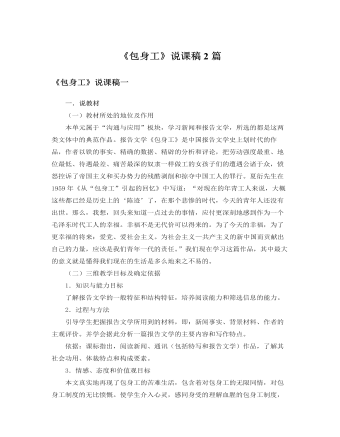
人教版高中语文必修1《包身工》说课稿2篇
(一)解题:包身工──旧社会一种变相的贩卖奴隶的形式。被贩卖的多是女孩子由承办人送到工厂做工,无人身自由,所得工资全部归承办人所有,在这种形式下做工的人也称包身工。包身工是指二三十年代(时间),在上海东洋纱厂里(地点),为外国人工作的女工(工作性质)。因为这些女工在进厂时已经签订了卖身契,失去了人身的自由权,所以被称为“包身工”。标题中的“包身”二字,突出了帝国主义、封建势力对中国女童工的残酷剥削的罪行,控诉了他们的野蛮残暴的统治手段,以激起人们的义愤和同情,这是全文的中心思想。(二)关于报告文学:《包身工》属于报告文学。(同类题材有初中的《地质之光》、《谁是最可爱的人》)报告文学,是文学体裁的一种,散文的一类,是文艺通讯、速写、特写的总称,是文学创作中的“轻骑兵”。
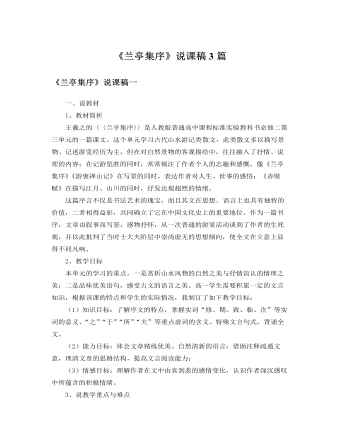
人教版高中语文必修2《兰亭集序》说课稿3篇
(二)分析课文,理清思路第1、2段为第一部分,主要是叙事、写景,先叙述集会的时间、地点,然后渲染出兰亭优美的自然环境。在这里足以“游目骋怀”“极视听之娱”,可以自由地观察、思考,满足人们目视耳闻的需求。这里正是与会“畅叙幽情”、尽兴尽欢的绝好处所。这些描写都富有诗情画意,作者的情感是轻松愉快的。第3、4段为第二部分,主要是抒情、议论,作者由美景妙时引发出乐与忧、生与死的感慨。他认为人生的快乐是有极限的,待快乐得到满足时,就会感觉兴味索然。往事转眼间便成为历史,人到了生命的尽头就会死亡。作者由“一死生为虚诞,齐彭殇为妄作”的认识,产生了一种珍惜时间、眷恋生活、热爱文明的思考。虽然文中的寿夭、生死不能自由决定,从而有些伤感,但作者仍然认识到盛衰、生死是必然的。人生无常,时不我待,故著文留传后世,以承袭前人,启示来者。
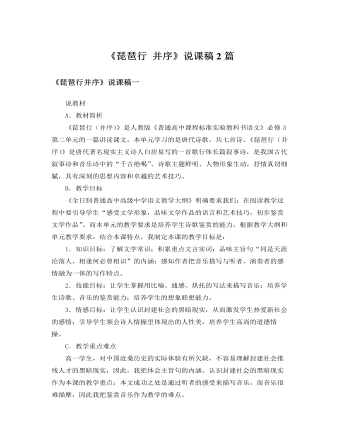
人教版高中语文必修3《琵琶行 并序》说课稿2篇
说教材A.教材简析《琵琶行(并序)》是人教版《普通高中课程标准实验教科书语文》必修3第二单元的一篇讲读课文。本单元学习的是唐代诗歌,共七首诗。《琵琶行(并序)》是唐代著名现实主义诗人白居易写的一首歌行体长篇叙事诗,是我国古代叙事诗和音乐诗中的“千古绝喝”。诗歌主题鲜明、人物形象生动,抒情真切细腻,具有深刻的思想内容和卓越的艺术技巧。B.教学目标《全日制普通高中高级中学语文教学大纲》明确要求我们:在阅读教学过程中要引导学生“感受文学形象,品味文学作品的语言和艺术技巧,初步鉴赏文学作品”。而本单元的教学要求是培养学生诗歌鉴赏的能力。根据教学大纲和单元教学要求,结合本课特点,我制定本课的教学目标是:1.知识目标:了解文学常识;积累重点文言实词;品味主旨句“同是天涯沦落人,相逢何必曾相识”的内涵;感知作者把音乐描写与听者、演奏者的感情融为一体的写作特点。
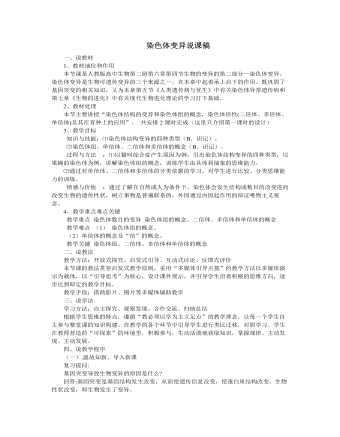
人教版高中生物必修2染色体变异说课稿
四、说教学程序(一).温故知新、导入新课复习提问:基因突变导致生物变异的原因是什么?回答:基因突变是基因结构发生改变,从而使遗传信息改变,使蛋白质结构改变、生物性状改变,即生物发生了变异。那么,基因是什么?它和染色体又有何关系?回答:基因是有遗传效应的DNA片断,染色体是DNA的载体,基因在染色体上呈线形排列。引出新知:对于一个生物体来说,正常情况下,其染色体的结构和数量都是稳定的。但在自然条件或人为因素的影响下,染色体的结构和数量均会发生改变,从而导致生物性状的改变,这就属于染色体变异。(二).把握重点、突破难点重点的把握:1、染色体结构的变异播放影片:猫叫综合征幼儿。让学生观察: 患儿哭声轻、音调高,很像猫叫。教师补充: 患儿的征状---两眼较低、耳位低下,存在着严重的智力障碍。阐述病因---染色体片段缺失

人教版高中英语必修4Body Language说课稿4篇
Textbook: Senior English for China (Book 4), by Liu Daoyi Time Allotment: 1 period (40 minutes)Date: March 20, 2014Teaching aids: blackboard, Multi-media, Power Point, chalk I. Text Analysis (教材分析)This unit is about body language, and the text selected in the reading part demonstrates the difference and similarity of body language in many parts of the world. Through learning this passage, students are required to raise their awareness of using body language in different parts of the world. As body language is closely related to our daily life, it is easy to arouse students’ interest in learning this text. Reading skills and speaking training are designed around the text.II. Teaching Objectives (教学目标)By the end of the lesson, students will be able to:1. Language Skill Objective(语言技能目标): develop reading ability (skimming and scanning)as well as speaking ability.2. Cultural Knowledge Objective(文化知识目标): know about the cultural differences of using body language.3. Affective Objective(情感目标): increase students’ awareness of using body language correctly in different cultures. III.Teaching Focuses and Difficulties(教学重点和难点)1. Teaching Focuses(教学重点): the difference and similarity of body language in many parts of the world.2. Teaching Difficulties(教学难点): develop students’ reading abilities of skimming and scanning and ask the students to show their opinions with fluent English.

人教版高中英语必修1Anne's best friend说课稿
Step 7 Language points 1.Vocabulary (1) go through (2) set down (3) a series of (4) on purpose (5) in order to (6)at dusk (7)entirely (8)face to face 2.Important sentences (1)…I’ve grown so crazy about everything to do with nature. (2)There was a time when … (3)I stayed awake on purpose until … (4)It was the first time … that I’d seen the night … (5)It’s no pleasure looking through … Purpose: 1.Master the required vocabulary and sentence structures. 2.Use them freely. Step 8 Consolidation 1.Find out the topic sentences 2.Retell the text according to the topic sentences Purpose: I want to know if my students understand the text. Step 9 Discussion Imagine you have to go into hiding like Anne and her family, what would you miss most? Giveyour reasons. Purpose: Train Ss’ oral English ability. Step 10 Homework Write an article on Friends. Purpose: 1. Improve the Ss’ writing ability. 2 Train the Ss’ ability of self—teaching and looking up information by themselves. Part 5 Blackboard design(说板书设计)Unit 1 Friendship Reading Anne’s Best Friend 1.Main idea of each paragraph: Para. 1 Anne made her diary her best friend. Para .2 Anne wrote her feelings in her diary. Para .3 Anne missed nature. Para.4 Anne saw the night face to face Para.5 Anne wanted to experience nature outdoors. 2.Listening: Exx.1 P3 3.Discussion: Exx.3 P3 Purpose: 1.Make Ss familiar with the passage 2.Make the design inductive, instructive and artistic.

人教版高中英语必修4A taste of English Humor说课稿3篇
Then I would ask them to think of a funny English or Chinese and tell it to partners. While telling stories, they can use expressions and some acting to help make the story funny. 5 minutes would be given to do this.Those stories they told there will be the material for their writing. Soletting them tell it at first is helpful. And they can make a difference between telling a funny story and writing it down. Generally speaking, it is difficult forstudents to write well because they don’t know what to write and how to write. Asking them to tell their own stories at first can help them come up with what to write.After their telling, I would invite someone to share his/her story with all of us and I would write it down on the blackboard.This example story would be used as a sample to illustrate the format of funny story. Different from a story from teacher or textbook, a story from students can obviously become a interesting material to draw students’ attention.Then I would ask the whole class to put this story into several parts. It might be a little bit difficult for them. So I would ask them to find out whether all the sentences are necessary. After delete some sentences, there are 6 sentences left behind. Then they can easily put them into three parts. After interaction with students, I would teach them the right terms for each part and conclude the format of funny story.This step is the key and difficult point in my lesson. So I mainly usetask-based teaching method in this part and the task for students was divided into several stages. With the separated difficult level, students can find there are usually three parts in writing. They can also learn to write without the unnecessary parts in the process of analyzing. And then I wouldn’t rush to tell them the right terms to them directly. Instead, I would ask them to name them by their own. A confused mind is better for acquiring knowledge.While-writing:Then I would give students 7 minutes to write down this story, without other requirements.With all the preparations in pre-writing, students’ difficulties were cleared. So it would be much easier for them to write down the story within 7 minutes. There are no other requirements because students’ first writing is actually a drafting. It would be revise and edit several times later. Writing, as a skill

人教版高中英语必修3Healthy Eating说课稿4篇
Language learning needs a context, which can help the learners to understand the language and then can product comprehensible output, so computer has the advantages to make the materials attractive.Part 3 Learning MethodsTask-based, self-dependent and cooperative learningPart 4 Teaching ProcedureStep One Lead-in“Interest is the best teacher.” Therefore, at the very beginning of the class, I should spark the students’ mind to focus on the centre topic “the band”. I’ll show some pictures of food to attract their attention and then bring some questions.Question:What kind of food they like?What should go into a good meal?The answers must relate to the diet. After this, the students will be eager to know something about a balance diet and this is the very time to naturally lead the class into Step 2Step 2 Reading for information: skimming and scanning In this step, I use Task-based Language Teaching method, which can give students a clear and specific purpose while skimming and scanning the context.Task 1 General ideaThe students will be asked to just glance at the title and the pictures of the passage, and then guess what they will read in the text. And they’ll be divided into groups of four to have a discussion.The purpose is to inspire the students to read actively, not passively. In addition, the task is to develop the students’ reading skill by making prediction and to encourage the students to express their thoughts in English and cooperate with each other.Task 2 Main idea of each paragraphCooperative learning can raise the students’ interest and create an atmosphere of achievement. Based on this theory, I divide the whole class into 4 groups to skim the whole text and get the main idea of each paragraph.

人教版高中英语必修5Life in the Future说课稿5篇
Good afternoon, everyone. It’s my great pleasure to be here sharing my lesson with you. The content of my lesson is Senior English for China Book5 Unit 3 Life in the Future. I’ll be ready to begin this lesson from six parts: Analysis of the teaching material, Analysis of the students, Teaching aims and important and difficult points, Teaching methods and aids, Teaching procedures, and Blackboard design. First, let me talk about the teaching material.Part 1 Analysis of the Teaching Material:This unit is about what human beings’ life will be like in about one thousand years. By studying of this unit, we’ll Enable the students to know the changes in humans’ life and some new inventions bringing about the change and develop the interest in science. This lesson plays an important part in the English teaching in this unit. This is an important lesson in Book Five. From this lesson, it starts asking the Ss to grasp contents of each passage. Therefore, this lesson is in the important position of the teaching material. If the Ss can learn it well, it will be helpful to make the Ss learn the rest of this unit.Part 2 Analysis of the SsAs Senior2 Ss, they are at different levels of English fluency, some of them have lost interest in English. So during the lesson, I arrange a variety of activities to let all of them join in to attract their interest and let them be confident and taste the joy of success.